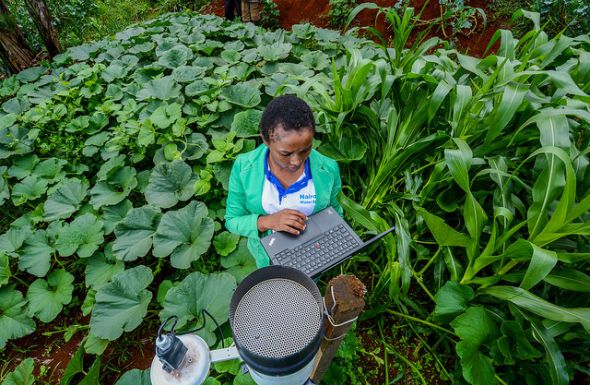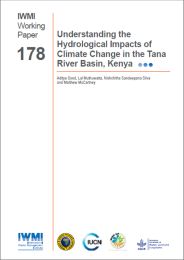It’s no joking matter in Kenya’s Tana River Basin

Collecting rainwater data on the farm. Photo: Georgina Smith / CIAT
The authors of a new study about climate change impacts in Kenya have both good news and bad for the country’s vital Tana River Basin. First, the good news: Mean annual rainfall may increase by up to 43% in the course of the 21st century, though with clear differences between rainfall in the upper, middle and lower parts of the basin. And now the bad: Extreme climate events, especially flooding, will also increase. The combined effect of this news will be to make water management in the basin a lot trickier during the decades to come.

New findings on the hydrological impacts of climate change in Kenya’s Tana River Basin are being released at the Global Landscapes Forum (GLF) 2017, held in Bonn, Germany, on December 19-20. Efforts to improve water and land management in the Tana Basin are in the spotlight during a GLF session hosted by the CGIAR Research Program on Water, Land and Ecosystems (WLE), along with the International Water Management Institute (IWMI) and International Center for Tropical Agriculture (CIAT).
How Kenya responds to this challenge will make an enormous difference to people and the environment. Consumers in the capital city, Nairobi, get 80% of their water from the Tana Basin. It also delivers 70% of the country’s hydroelectric power and 35% of its total electricity supply. The basin is home to 18% of the country’s population, and its agriculture provides food and jobs for close to seven million people.
Nature-based solutions
The new results come from a project called WISE-UP to Climate (Water Infrastructure Solutions from Ecosystem Services Underpinning Climate Resilient Policies and Progammes), which is led by the International Union for Conservation of Nature (IUCN). With support from the German government, the project brings together a half dozen national and international partners. Among them is the International Water Management Institute (IWMI), which published the results in a report titled Understanding the Hydrological Impacts of Climate Change in the Tana River Basin, Kenya (IWMI Working Paper 178).
Working in both the Tana Basin and West Africa’s Volta River Basin, project researchers aim to demonstrate how “nature-based” solutions can contribute to climate change adaptation and sustainable development. These draw on “portfolios” of both built and natural infrastructure, with the former consisting of dams, levees and so forth, and the latter encompassing wetlands, floodplains and watersheds.
Ecosystems in the balance
With another annual UN climate change conference just come and gone, the study results provide a helpful reminder that water is the primary medium by which economies, societies and landscapes will experience the impacts of climate change.
How those impacts play out depends a lot on what happens to ecosystem services. These are the multiple benefits that ecosystems provide, including the delivery of water for agriculture as well as domestic and industrial use. The fate of ecosystem services hangs in the balance, depending greatly on how both natural and built infrastructure interact and are managed under future climate conditions.

Photo: Georgina Smith / CIAT
The new study focused specifically on ecosystem services that shape the ability of built infrastructure to deliver its intended benefits. These services typically correspond to key hydrological features of a river basin. “Water flow” and “groundwater recharge,” for example, represent the total quantity of water available, while “flow regulation” suggests when river water is available. There are already five major dams in the basin, with several more planned. So, knowing in clear technical terms how climate change might affect the hydrology of the basin and, hence, the performance of these costly investments is extremely important for water managers and policy makers.
For this study, researchers used a hydrological model, called the Soil and Water Assessment Tool (SWAT) to simulate the ecosystem services for three future periods. Climate change input came from an ensemble of six models, making it possible to compare a range of greenhouse gas emission scenarios. The researchers then evaluated climate change impacts by comparing these scenarios with the basin’s current situation.
Taking the bad with the good
It helps when scientists agree on things, and in this case, the new results match the findings of previous studies. All point to the same conclusion – a likely reversal of the recent historic trend of declining rainfall. Increasing rainfall in the Tana Basin throughout the 21st century will translate into new opportunities for deriving benefits from built infrastructure – that is, more hydropower, water supplies and irrigation capacity.
The downside is that more water also means more risks, which could undermine new development opportunities. A major source of those risks is increased rainfall variability, which will result in bigger and more frequent floods.
What can the government do to ensure that the extra benefits from increased water supplies aren’t literally washed away? Built infrastructure by itself will not be enough. Kenyan experts in water policy and practice must gain a better understanding of the role that natural infrastructure plays in the basin and acquire the new skills needed to optimize the benefits, while ensuring sustainable and equitable management of water and land.
Climate change will complicate matters by introducing greater complexity and uncertainty. The government’s challenge is to strike a balance, promoting adaptation simultaneously with development and learning to minimize the bad, while optimizing the good.


